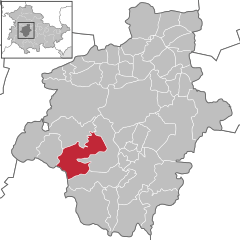Friedrichroda
| Friedrichroda | ||
|---|---|---|
 | ||
| ||
 Friedrichroda | ||
Location of Friedrichroda within Gotha district 
 | ||
| Coordinates: 50°52′0″N 10°34′0″E / 50.86667°N 10.56667°ECoordinates: 50°52′0″N 10°34′0″E / 50.86667°N 10.56667°E | ||
| Country | Germany | |
| State | Thuringia | |
| District | Gotha | |
| Government | ||
| • Mayor | Thomas Klöppel (SPD) | |
| Area | ||
| • Total | 36.91 km2 (14.25 sq mi) | |
| Elevation | 430 m (1,410 ft) | |
| Population (2012-12-31)[1] | ||
| • Total | 7,392 | |
| • Density | 200/km2 (520/sq mi) | |
| Time zone | CET/CEST (UTC+1/+2) | |
| Postal codes | 99892–99894 | |
| Dialling codes | 03623 | |
| Vehicle registration | GTH | |
| Website | www.friedrichroda.de | |
Friedrichroda is a town in the district of Gotha, Thuringia, Germany. It is situated at the north foot of the Thuringian Forest, 21 km by rail southwest of the town of Gotha. It is surrounded by fir-clad hills and possesses numerous handsome villa residences, a Kurhaus and a sanatorium. In the immediate neighborhood is the beautiful ducal hunting seat of Reinhardsbrunn, built out of the ruins of the famous Benedictine monastery founded in 1085. On 1 December 2007, the former municipalities Ernstroda and Finsterbergen were incorporated by Friedrichroda.
Development of First Jet Aircraft
During the late years of World War II, Friedrichroda was the site of manufacture of the mock-up production of the double-seat, all-weather fighter version of the Horten Ho 229 V4 and V5 (Versions 4 & 5) jet aircraft. The only surviving example of the Horten jet is the Horten Ho 229 V3. In December, 2011, the Horten V3 was transferred to the Smithsonian Institution's Paul E.Garber Restoration Facility in Suitland, MD.
Gallery
-
Friedrichroda "Blasius" church
-
Stone head
-
Memorial for victims of an air raid in Friedrichroda
References
| Wikimedia Commons has media related to Friedrichroda. |
- ↑ "Bevölkerung der Gemeinden, erfüllenden Gemeinden und Verwaltungsgemeinschaften nach Geschlecht in Thüringen". Thüringer Landesamt für Statistik (in German). 13 July 2013.
 Chisholm, Hugh, ed. (1911). "Friedrichroda". Encyclopædia Britannica (11th ed.). Cambridge University Press
Chisholm, Hugh, ed. (1911). "Friedrichroda". Encyclopædia Britannica (11th ed.). Cambridge University Press



